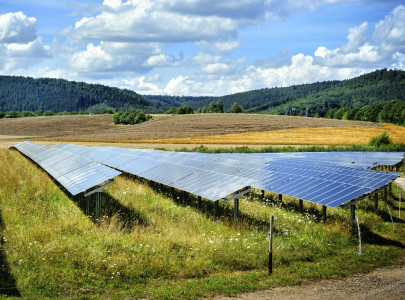The solar energy industry is booming. But who’s being left out of the equation?
In 2014, the U.S. residential solar market alone experienced more than 50 percent growth. This increase has allowed homeowners with the proper resources (and the right houses) to invest in energy solutions that directly benefit their households and give them the chance to participate in the clean energy movement.
Solar panels may be a long-term boon, but the up-front costs (and housing specifics) often make it hard for many people to make the switch. That’s why communities are banding together to use solar collectively. Thanks to legislation like President Obama’s Clean Power Plan, entire communities now have incentive to switch to clean energy and solar energy serves as the most viable options for these groups.
What does that mean? Think of a solar farm (or a field of solar panels!), located in a community area, to which participants in the community all have access. Instead of having solar panels installed on your house, you help pay for and support a bunch of solar panels, and reap the benefits of the farm in your energy bill.
When a community decides to “go solar,” its members collectively decide to use solar power. Neighborhoods, organizations and municipalities all count as communities within the solar industry. This community-sharing alternative helps to relieve the upfront costs of solar power installation costs and allows members of the community to get clean energy sooner.
Interested in community solar? Curious if it’s right for your town, faith institution, or neighborhood? Read on!
What Exactly is a Community Solar Program?
 Community solar can make renewable energy more accessible to low and middle-income communities.
Community solar can make renewable energy more accessible to low and middle-income communities.Community solar programs (also called “community solar gardens” or “shared solar programs”) are solar power sharing programs for individuals or organizations. Commonly, these programs benefit people who do not have the resources or space to generate solar power on their own. These programs allow people access to a clean energy source and the savings that go with it (Interstate Renewable Energy Council).
Frequently, community solar programs are set up and run by local utility companies. But that’s not the only way that groups are switching. Some invest in their own solar projects or support solar projects started by other organizations.
How Do Community Solar Programs Work?
There are a variety of ways that community solar programs are set up. On a basic level, these programs allow participants to either subscribe to a solar program that already exists or contribute to the installation of a new solar project within their area.
If community members chooses to subscribe to an existing solar program, there are some real and meaningful ways they benefit. As the solar panels make energy from the sun, the farm turns a profit, which is passed on to the subscribers. Frequently, participants get a share in the resulting solar profits, or they may simply receive their power from the installed solar farm.
The rising popularity and general newness of these programs makes predicting their format difficult. Not every model works best for every community, but each program can be adapted to fit a community’s unique needs.
What are the Benefits of Community Solar?
In addition to providing the opportunity to engage in clean energy initiatives, community solar programs provide several other benefits to the areas in which they are created. The clearest benefit is providing clean energy options to folks who aren’t able to participate on their own. Having a community solar program levels the playing field in terms of equity in the clean energy space, allowing broader group of people to participate.
Another benefit to community solar programs are the increased job opportunities that they bring to communities. With all the federal and state funding supporting solar innovation, projects, and training, community solar programs allow citizens to access employment opportunities to install and maintain the solar farm.
Additionally, community members have the opportunity to promote clean energy in their communities. These programs allow members of the entire community to make strides toward a more sustainable way of life.
How Can People Get Involved?
With such great economical and environmental benefits, community solar programs are set to take off, but they’re not yet available everywhere yet. In the mean time, look for ways that you can prepare when community solar becomes available in your region.
Research your state’s legislation on community solar programs and find out how to participate. Contact leaders in your community and help them to become knowledgeable about ways they can participate in community solar. Finally, spread the word about community solar to your friends and neighbors to help make community solar a reality in your area. The one thing community solar needs most is communities in which to operate—maybe yours can be next!
Imani Lewis is an artist, advocate, and Editorial Fellow at Groundswell, currently living on the outskirts of Washington, D.C. When she’s not dreaming up ideas to change the world, you’ll find her perusing Soundcloud and pretending not to like Taylor Swift. Connect with her on Twitter at @imanirlewis.
